The Debate: Steam Cleaning Versus Traditional Leather Care
Posted on 22/08/2025
The Debate: Steam Cleaning Versus Traditional Leather Care
Leather is a luxurious, timeless material that adds elegance and comfort to furniture, car interiors, clothing, and accessories. However, maintaining its polished appearance and durability requires careful attention. Over the years, leather care methods have evolved, with steam cleaning emerging as a modern technique vying for attention against traditional leather cleaning practices. This has sparked a lively debate within the cleaning and restoration industry and among consumers: Is steam cleaning better for leather, or should we stick to the tried-and-true traditional leather care?

Understanding Leather: Types and Properties
To appreciate the pros and cons of each leather cleaning method, it's essential to understand leather's complex structure. Leather is essentially animal hide that has been tanned and treated for durability and aesthetics. However, not all leather is created equal--different types require different care techniques. The most common types include:
- Full-grain leather: The highest quality, with an intact natural surface.
- Top-grain leather: Sanded and treated for a uniform finish.
- Corrected-grain leather: Buffed and embossed for aesthetic consistency.
- Bonded leather: Made from leftover hide pieces glued together.
The porousness, finish, and thickness of leather all impact how it responds to different cleaning techniques. Understanding your leather's type can prevent irreversible damage during cleaning.
What Is Traditional Leather Care?
Traditional leather care methods have been passed down through the generations and often involve a combination of gentle cleaning, conditioning, and protection. The usual steps include:
- Dusting: Using a soft, dry cloth to remove surface dirt and debris.
- Cleansing: Applying a pH-balanced leather cleaner or a mild soap solution sparingly to lift grime.
- Conditioning: Using leather conditioners to replace lost oils and prevent drying or cracking.
- Protection: Applying a finishing cream or barrier to reduce stains and UV damage.
These methods aim to preserve the leather's natural oils, suppleness, and sheen and are generally safe for most types. But, they can be time-consuming and may not always remove deep-seated stains or embedded bacteria.
Pros of Traditional Leather Care:
- Maintains the natural integrity of leather fibers.
- Helps prevent drying, cracking, and premature aging.
- Safe for delicate and high-end leathers.
- Widely recommended by luxury leather brands.
Cons of Traditional Leather Care:
- May not remove bacteria, mold, or odors effectively.
- Labor-intensive and may require multiple products.
- Ineffective against deep or stubborn stains.
The Rise of Steam Cleaning for Leather
Steam cleaning, once associated almost exclusively with carpets and hard surfaces, has gained popularity as a potential technique for cleaning leather items. Modern steam cleaners employ controlled bursts of pressurized hot steam to penetrate into pore structures and dislodge dirt, grease, and bacteria.
Proponents claim that steam cleaning leather can sanitize and refresh without the need for chemical cleaners, making it appealing for eco-conscious users. But critics warn of risks, especially if the process is performed incorrectly or with inappropriate equipment.
How Does Steam Cleaning Work?
- Water is heated in a steam cleaner to produce vapor up to 110?C-130?C (230?F-266?F).
- The vapor is applied to leather surfaces through a specialized nozzle, sometimes with an absorbent cloth cover.
- The heat loosens embedded dirt, which is then wiped away immediately.
It's important to note that not all steam cleaners are suitable for leather, and settings must be carefully controlled to avoid overheating or soaking the hide.
Pros of Steam Cleaning Leather:
- Deeply sanitizes by killing bacteria, dust mites, and mold.
- Effective at removing persistent odors and tough biological stains.
- Reduces reliance on chemicals and cleaners.
- Saves time and labor compared to multi-step traditional cleaning.
Cons of Steam Cleaning Leather:
- Possible moisture intrusion causing warping, staining, or mildew.
- High heat can dry out or damage leather fibers, especially delicate types.
- May void warranties or recommendations from leather manufacturers.
- Requires experience and specialized equipment for safe application.
Comparing the Two Methods: Steam Versus Traditional Leather Cleaning
So, which is superior: steam cleaning leather or traditional leather care techniques? The answer depends on your leather item, the severity of soiling, and the outcomes you desire. Let's explore several key factors:
1. Effectiveness Against Stains and Odors
- Steam cleaning: More effective at loosening stubborn, embedded grime as well as unpleasing organic smells such as smoke, sweat, and food odors.
- Traditional care: While gentle, can struggle with pungent odors or stains that have penetrated the hide.
2. Preservation of Leather's Natural Qualities
- Traditional techniques: Focus on maintaining moisture, oils, and the organic integrity of the leather.
- Steam cleaning: If misapplied, could result in the loss of natural oils and premature aging or cracking.
3. Safety Across Leather Types
- Delicate leathers: Such as full-grain or aniline, are safest with traditional hand-cleaning methods.
- Hardier, corrected leathers: May tolerate low-moisture steam, but always conduct a patch test first.
4. Environmental Impact
- Steam cleaning: Environmentally friendly due to less chemical use.
- Traditional cleaning: Often requires commercial cleaners and conditioners, though natural or plant-based options exist.
5. Longevity and Appearance
- Traditional: Regular conditioning prolongs leather life and enhances its patina.
- Steam: Frequent, improper use may dull the finish and reduce structural integrity over time.
What Experts and Manufacturers Say
Major leather furniture and automotive brands typically advise against steam cleaning for most of their products, especially high-quality, permeable types. Leather professionals and tanneries echo this caution, noting that excessive heat and moisture can irrevocably damage the hide. Some manufacturers, however, allow or even recommend steam cleaning for specific, coated leathers--but only under strict conditions and with professional equipment.
Pay attention to manufacturer care labels and always test cleaning techniques on a hidden section first. Consulting a leather care specialist is strongly recommended for antique or premium leather items.
Best Practices for Steam Cleaning Leather
If you choose to steam clean your leather, follow these best practices to minimize risk and maximize results:
- Use a steam cleaner with adjustable temperature and vapor output.
- Attach a soft, microfiber cloth or wool pad to the nozzle to diffuse heat and catch loosened debris.
- Hold the nozzle at least six inches from the surface to avoid concentrating heat in one spot.
- Work in small sections and avoid saturating the leather with too much moisture.
- Immediately wipe away excess moisture with a clean, dry, lint-free cloth.
- After steam cleaning, apply a high-quality leather conditioner to restore lost oils and suppleness.
Never use steam cleaning on suede, nubuck, or aniline leather, which are far too delicate and absorbent. These types of leather are better maintained through traditional care methods.
Combine Both Methods? A Hybrid Approach
For many leather owners, a hybrid approach can be ideal. Reserve traditional leather cleaning and conditioning for routine maintenance, and use steam cleaning only for periodic deep sanitizing--or in situations where odor and heavy contamination are present. Maintaining a balance ensures both cleanliness and preservation of the leather's natural beauty.
DIY vs. Professional Services: Who Should Clean Your Leather?
While many homeowners attempt both traditional and steam cleaning as DIY projects, it's crucial to recognize your own limits and the value of your leather item.
- DIY traditional leather cleaning is safe for general soiling and conditioning using gentle, pH-balanced products.
- Professional steam cleaning is recommended for large, heavily soiled items, or when dealing with biohazards like mold or urine stains.
- Do not try steam cleaning without proper equipment and training, as mistakes can lead to irreversible damage.

Tips for Long-Term Leather Care
Regardless of your chosen method in the debate of steam cleaning versus traditional leather care, the following tips will prolong your leather's life and beauty:
- Keep leather items out of direct sunlight and away from intense heat sources.
- Clean up spills immediately to avoid staining and moisture penetration.
- Condition your leather at least every six months (or as recommended by the manufacturer).
- Vacuum upholstered leather furniture regularly with a soft-bristle attachment.
- Test any new cleaning product or technique on a hidden area first.
Conclusion: The Verdict on Steam Cleaning versus Traditional Leather Care
The debate between steam cleaning leather and traditional leather care techniques continues, and for good reason. Each method has distinct advantages and disadvantages depending on your leather type, cleaning needs, and risk tolerance.
Traditional leather care remains the gold standard for preserving antique, high-end, and delicate leathers, ensuring longevity, suppleness, and a stunning appearance with minimal risk. Steam cleaning offers the powerful ability to sanitize, deodorize, and deep-clean modern, sealed leathers--but must be done with vigilance and proper equipment, ideally by professionals.
The best approach? Stay informed, read manufacturer's recommendations, and don't be afraid to consult with leather care experts. By understanding the strengths and risks of both methods, you can keep your leather possessions looking their absolute best for years to come.
Key Takeaways:
- Steam cleaning leather is highly effective but carries risk--choose carefully.
- Professional-grade, cautious steam use can be beneficial for specific, sealed leathers.
- Traditional cleaning and conditioning are safest and support long-term leather integrity.
- A hybrid approach often yields the best results for leather care, especially for diverse household needs.
Ready to care for your treasured leather pieces? Start with gentle, regular maintenance, and only consider steam cleaning when truly needed--and never at the risk of damaging your beautiful investment.



